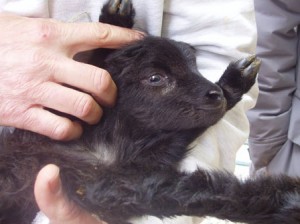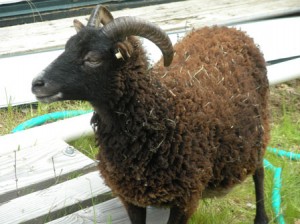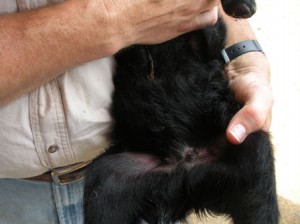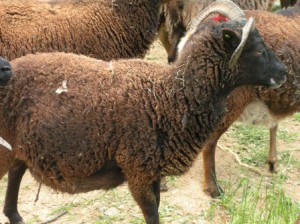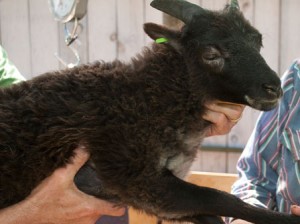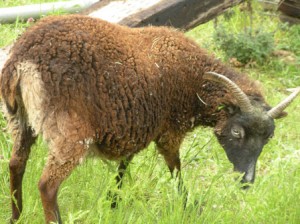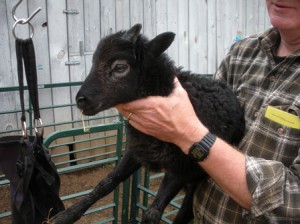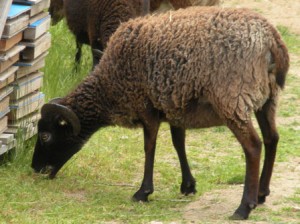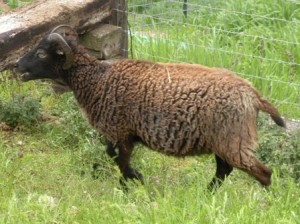Color and pattern in Soay sheep: an update
Regular readers of this blog will remember the three-part series of posts I put up in March 2011 to introduce the new fleece colors and patterns that resulted from adding two new rams to our breeding program: Mustard and Norris. Both of these rams lived in Wales at the time, but they donated their sperm for a successful artificial insemination program in 2008 and 2009 designed to broaden the diversity of the British Soay flock in North America.
When I was out looking at our pregnant ewes a few days ago, I was struck again at the lovely new almost-black, dark grey British Soay sheep that started appearing in the lambs sired by Mustard and Norris and in their grandchildren. We thought you might like to see how three of the ewe lambs pictured in those earlier posts look after several years of growth and sun bleaching. All three of them still are mostly uniformly colored, that is, there is very little difference between the color of the fleece on their backs and on their bellies. They are roughly the same dark color all over, but not as absolute as if they were self-colored. Each of them has had since birth or has developed some lightening of their bellies, odd little white marks on one side of their lips, lighter hair in their ears, that sort of thing.
Vieva was one of our original Norris-sired lambs in 2008. Look at how black she was at birth and what has happened to her in the intervening years. When she was born the only non-black on her was a slightly lighter grey around her eyes, almost like a reverse raccoon, and a small area of light grey fleece on her belly. In the intervening years, her belly has lightened more; she has developed a little smudge of white on her nose, and a white dot on her lip.
I should mention that Vieva’s mother, Josephine, was typical of the look of the original flock of RBST Soay from Canada: nice brown fleece, nice white belly, a triangular-shaped light place just below each eye, right out of central Soay casting. We had no reason to expect a black lamb from her.
In 2009, long after the rest of the lambs had arrived, we came out to the play yard one day only to discover a beautiful little black British ewe lamb, Heywood. She was conceived the last night before the ram had to leave the breeding area and head back to the bull pen. We were stunned. Her father is Curtis, son of Norris, but her mother is Xanthoria, one of our conventional ewes. It turns out even at birth Heywood had slightly lighter circles around her eyes, like Vieva, but also a small area of light grey, almost white, hairs around her mammae, a tell-tale sign she is not really self-colored. She still is pretty much black colored at the age of 4 years, but she too has developed a whiter spot on one of her lips and her belly is noticeably lighter at this point.
In retrospect, we should not have been as surprised by Heywood as we were by Vieva, since Heywood’s mother, Xanthoria, has a lot of dark grey color in her fleece and very dark legs.
A third black ewe featured in my earlier posts is Cley, a 2010 lamb sired by Dean, son of Mustard, the other donor ram. Oh yes, and Cley’s mother is Xanthoria, so Cley and Heywood are half-sisters. At first we thought Cley would turn out to be another fully black ewe as well, but by 3 months she already had a slightly lighter belly, although not nearly as pronounced as the typical mouflon Soay:
Shortly after I put up those three posts in 2011, yet another color surprise arrived — Darby, a pretty little ewe lamb produced by breeding Buckley (Mustard’s son) to Vieva (Norris’ daughter). You may remember Buckley, also featured in the 3-part series in 2011. He’s the ram with the black coat and white private parts.
Here is Darby as a lamb:
I know what you are thinking: “could Priscilla please move on? How many dark grey sun bleached ewes do we need to see to get the point?” Fair enough, but have a look at Darby a couple of weeks ago at age two:
Darby’s unusual fleece is more than sun bleaching. It looks this way year-round, even after she sheds in late spring. She is an odd combination of light brown and light grey and you’d swear when you see her up close that she had been sprayed with a smidgeon of pale purple frosting. Here’s another picture of her in green grass, just to confirm that the color of her fleece you see is natural and not doctored in the photo.
For those of us fascinated with the formal genetics of pattern and color, these ewes would at first appear to have been self-colored at birth … except for the white hairs, lighter spots on their bellies, and so forth. But look what happened to them as they matured. That change in pattern, the intensification of their eye rings, and the white spots on their lips, never happens with self-colored darks. When they are born, they look as though they have been dipped in a vat of jetblack ink, with no white mammary hairs, no lighter patches on their bellies, no light spots on their lips or in their ears, nothing. Self-coloration is the complete absence of pattern, so if an animal is self-colored its fleece will remain all one color throughout its life, with lightening only on its back from sun bleaching.
There has never been a self-colored British Soay in the North American-based flock that originated in Athelstan, Canada. The only way to re-introduce self-coloration (which is present in the U.K.-based flock) is through artificial insemination using donor rams from the U.K. Mustard was reported to carry self, and Norris was reported to have a self-colored grandmother, so if their offspring also carry self-coloration, it should be possible to produce self-colored British Soay in North America by breeding Norris descendants to each other, or Mustard descendants to each other, or a Norris descendant to a Mustard descendant.
We had one such breeding in 2011, Buckley to Vieva, and we got Darby. She is not self-colored but she surely is an interesting color. This year we have several breeding pairs that could produce a self-colored lamb. You can be sure that if we get one, we will be sharing pictures! Stay tuned.
For now …
